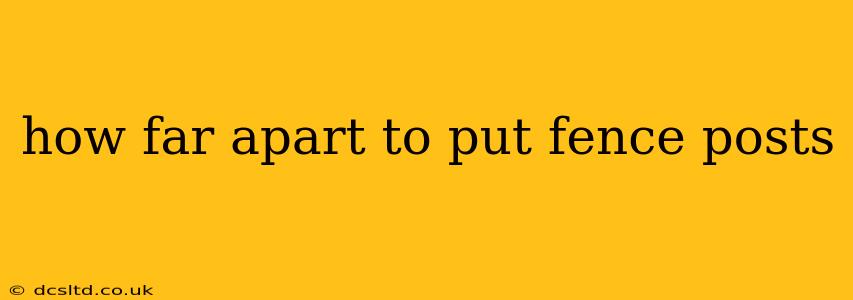How Far Apart to Put Fence Posts: A Comprehensive Guide
Choosing the right spacing for your fence posts is crucial for a strong, long-lasting, and aesthetically pleasing fence. The ideal distance depends on several factors, including the type of fence, the height of the fence, the type of soil, and the local climate. This guide will help you determine the optimal spacing for your project.
Factors Affecting Fence Post Spacing
Before diving into specific distances, let's examine the key elements influencing post placement:
-
Fence Type: Lightweight fences, such as those made of chain link or lightweight wire mesh, require less support and can have wider spacing. Heavier fences, like those made of wood, vinyl, or metal panels, need more robust support and closer post spacing.
-
Fence Height: Taller fences require more support and, therefore, closer post spacing. The added weight and wind pressure necessitate stronger intervals to prevent sagging and instability.
-
Soil Conditions: Well-drained, stable soil can handle wider spacing compared to loose, sandy, or clay-rich soil. Less stable soil needs more frequent posts to provide adequate support.
-
Climate: Areas with strong winds or heavy snowfall require closer post spacing to withstand increased stress.
-
Post Material: The material itself impacts the necessary support. Pressure-treated lumber, for instance, may allow slightly wider spacing than less durable materials.
How Far Apart Should Fence Posts Be? General Guidelines
While there's no single "perfect" distance, here are general guidelines:
-
Wood Fence Posts: For standard 4-6 foot high wooden fences, spacing of 6-8 feet is common. However, for taller fences or less stable soil, reducing this spacing to 6 feet or even 5 feet might be necessary.
-
Chain Link Fence Posts: Chain link fences can generally tolerate wider spacing, ranging from 8-12 feet apart, particularly for shorter fences. However, remember to account for terrain and wind exposure.
-
Vinyl Fence Posts: Vinyl fences are often heavier than chain link but lighter than some wood fences. Spacing between 6-8 feet is usually appropriate, with adjustments for height and soil conditions.
-
Metal Fence Posts: Similar to vinyl, metal fences will require spacing that takes into consideration height and soil conditions. Often 6-8 feet is a safe bet, though this may vary with the fence's design and weight.
What About Corner Posts and End Posts?
Corner and end posts require extra support and are always spaced closer than the other posts. They should always be placed firmly and deeply embedded in the ground.
How to Determine the Best Spacing for Your Fence
-
Assess your site: Consider the factors mentioned above: fence type, height, soil, climate, and post material.
-
Consult local building codes: Your local municipality may have specific regulations regarding fence construction and post spacing.
-
Seek professional advice: If you're unsure, consult a fencing professional or contractor. They can assess your site and recommend the best spacing for your needs.
Frequently Asked Questions (FAQs)
H2: What happens if my fence posts are too far apart?
If your fence posts are too far apart, the fence will likely sag, become unstable, and be more susceptible to damage from wind or other external forces. This can compromise the fence's structural integrity and safety.
H2: Can I use smaller posts if I space them closer together?
While closer spacing reduces the load on individual posts, using smaller posts compromises overall strength and longevity. The appropriate post size is critical for structural integrity, regardless of spacing. It's best to use the recommended post size for your fence height and type, even with closer spacing.
H2: How deep should I bury my fence posts?
Post depth is as critical as spacing. Aim for at least one-third of the post's above-ground height to be buried, offering stability and resistance to uprooting. This usually translates to at least 2-3 feet in the ground.
H2: What type of post is best for my fence?
The best post material depends on several factors, including your budget, aesthetic preferences, and the local climate. Pressure-treated lumber is a popular and durable choice for many situations. Metal and vinyl posts offer additional benefits, such as minimal maintenance and resistance to rot.
By carefully considering these factors and following these guidelines, you can ensure your fence posts are spaced correctly for a strong, beautiful, and long-lasting fence. Remember that proper post placement is key to preventing sagging, bowing, and other structural issues.
